March 29, 2017
Thirty years ago this week, an 18-month struggle over the future of federal highway and mass transit funding came to a head: President Ronald Reagan became the first chief executive to veto a federal-aid highway authorization bill, and Congress overrode the veto. (Though it took two tries in the Senate.)
(Click here to download the Documentary History of the 1987 Highway Bill Veto – a large PDF file that contains this narrative along with dozens of original documents (mostly from the Reagan Library) that are hyperlinked from the appropriate place in the narrative. Readers are encouraged to download the PDF file instead of viewing it through a browser so they can use the bookmarks and jump to documents separately.)
The 1987 veto struggle began about a year-and-a-half earlier, on July 31, 1985, when House Highways Subcommittee chairman Glenn Anderson (D-CA) introduced a five-year highway and transit reauthorization bill (H.R. 3129, 99th Congress).
On September 10, Transportation Secretary Elizabeth Dole wrote House Public Works and Transportation full committee chairman Jim Howard (D-NJ) a letter criticizing the specifics of the House bill, saying “I would recommend to the President that he veto any bill that contains these provisions.”
Under the process in place at the time, Congress needed to approve an Interstate Cost Estimate (ICE) by October 1985 to allow the apportionment of the next round of Interstate construction funding – but, the existing Highway Trust Fund authorizations were not due to expire until October 1986.
Howard had hoped to do both in one bill in 1985, but they wound up enacting a separate ICE (Public Law 99-104) and saved the reauthorization for 1986. The subcommittee marked up the bill in June 1986, and just before that markup, the White House Office of Management and Budget sent a letter to chairman Howard threatening a veto. Public Works approved the bill on June 25 and filed its report on July 2 (H. Rept. 99-665).
Talking points for a White House meeting on July 18 listed the various failings of the House bill, and an internal White House Office of Legislative Affairs memo from later that day said that chairman Howard “has elicited promises from every member who requested a project to vote against a 55-mph amendment, for his off-budget amendment, and for final passage…the only way we will get an acceptable bill out of conference is for the Administration to communicate a clear and unequivocal veto signal in the House. Even then, the outlook for showing veto strength on a final passage vote appears grim at this time…”
House Public Works had to wait for Ways and Means to mark up its tax title of the bill on July 22 before moving to the House floor, where after debating and amending the bill, the House demonstrated that White House legislative affairs aides had been correct – the bill passed on August 15 by a way-veto-proof supermajority of 345-34 (91 percent of those voting supported the bill, well over two-thirds).
The Senate companion bill (S. 2405, 99th Congress) had been introduced in May 1986 and was much more to the White House’s liking. As the Senate Environment and Public Works Committee prepared to mark up the bill in July 1985, OMB sent chairman Robert Stafford (R-NH) a letter in general support of the bill but urging the committee to address a few areas of concern. The Senate committee reported the bill on August 5 (S. Rept. 99-369) and debated and amended the bill over September 23-24 before substituting its amended text for H.R. 3129 and passing the amended bill by a vote of 99-0.
The main differences between the House and Senate bills were: (1) the House bill spent more on highways and a lot more on mass transit; (2) the Senate bill increased the maximum speed limit in rural areas from 55 miles per hour to 65 mph and the House bill did not; and (3) the House bill had extra funding for over a hundred earmarked “demonstration projects” for important members (including what would be come the “Big Dig” for Speaker O’Neill), while the Senate bill had fewer projects (but they were all funded out of state formula money).
The Senate named conferees on the bill on September 25, but the House initially refused to go to conference unless the Senate first agreed to drop the 65 mph speed limit provision (1986 CQ Almanac 286). But the House backed down and announced on October 1 that conferees had been named. On October 2, both the White House and DOT sent letters to the conferees outlining the Administration’s views (with the White House letter reiterating the veto threat). The conferees met on October 3 and again on the 7th, when Senate conferees made an offer to the House that held fast on the speed limit and the demo projects.
The House took its time responding, leading Senate conferees to write a letter to Howard on the 15th urging him to hold another conference meeting. The conferees met again on the 16th, where the House made a counter-offer that showed little flexibility on demo projects and none whatsoever on the speed limit. Howard then issued a press release criticizing the Senate for being inflexible. No further progress was made, and the Congress adjourned on October 18 without taking any further action on the bill.
In the November elections, the GOP lost control of the Senate, and Howard planned to introduce a new bill when the new Congress convened in January that included all tentative agreements made in conference and reiterated the House position on everything else.
The end of the 99th Congress marked the retirement of Tip O’Neill (D-MA) as Speaker of the House and put Jim Wright (D-TX) in the Speaker’s chair. Wright’s biographer, John M. Barry, was embedded in Wright’s office during this time and wrote extensively about the 1987 experience in The Ambition and the Power (Viking, 1989). Wright and Senate Majority Leader Robert Byrd (D-WV) wanted a fast start to the 100th Congress, and Wright turned to Jim Howard to provide it.
Wright knew the Public Works and Transportation Committee well. He was a longtime member, and he’d had the seniority to be chairman of the House Public Works and Transportation for ten years by the time he became Speaker. But Wright instead ran for Majority Leader in 1976 and won (by one vote), which precluded him from chairing any committees (Wright had even married a Public Works staffer).
Wright asked Howard to start the new Congress by moving two veto-bait bills from the prior Congress through the House as quickly as possible in the new 100th Congress – H.R. 1, the Clean Water Act reauthorization, and H.R. 2, the highway bill. “Even though Howard ran perhaps the most bipartisan committee in Congress and his Republicans might not like being used as pawns in a battle against their President, Howard agreed to Wright’s request” (Barry 62).
Howard then introduced H.R. 1 and H.R. 2 on Opening Day, with the White House immediately issuing a Statement of Administration Policy threatening a veto. An internal White House memo from January 7 noted “There has to be action on this bill before March 1, 1987, when funds begin to run out in the states.”
H.R. 2 passed the House on January 21 by a huge margin of 401-20. The Senate had been producing its own bill, with the Public Works Committee reporting S. 387 on January 27 (S. Rept. 100-4), and the Banking Committee reporting S. 382 (the transit provisions) the same day (S. Rept. 100-3). A White House memo the following day predicted which amendments would be offered on the Senate floor and expressed concern that the mass transit provisions in both House and Senate bills might be so high as to justify a veto. The White House also threatened a veto if the Senate adopted a Byrd (D-WV) Buy America amendment.
The Senate passed the amended H.R. 2 on February 4 by a vote of 96-2 (the only “no” votes were Armstrong (R-CO) and Roth (R-DE)). A White House OMB memo to chief of staff Don Regan on February 9 saying, “Our concerns have not been addressed. In fact, the Senate made the highway bill worse by adding 63 pork projects and the Senate Banking Committee transit provisions we oppose. OMB and DOT support a veto of a conference bill that does not address our transit concerns or includes the House highway provisions…DOT and OMB believe that we should maintain our veto position because there is no way conference could address our concerns.” That memo also had an attachment comparing the funding levels in the House and Senate bills with the President’s request.
A February 11 memo from the White House Office of Legislative Affairs argued that if the White House senior staff agreed with the OMB-DOT recommendation, “that decision must be communicated in the strongest possible terms to the conferees prior to the Conference” but noted the obstacles:
“Given the current climate – states running short on highway funds and the attendant contract/labor problems – it will be extremely difficult to sustain a veto of a highway bill containing any of the major provisions objectionable to the Administration. The best chance of sustaining a veto will be if the conference product contains the House scheme, or something close to it, for funding of demonstration projects. In that case, the sentiment in the Senate may well be to sustain the veto, since the key actors in the Senate feel that they exercised restraint in funding for demo projects, while the House has not. A veto solely on the basis of the funding levels in either the House or Senate versions for highways or mass transit will be much tougher to sustain.”
The memo recommended meeting with Senate Public Works chairman Quentin Burdick (D-ND), who opposed the House demonstration projects and who presumably would chair the conference committee, to attempt to get Burdick to use his clout to shape the final conference product to the White House’s liking.

Internal White House memo from Henry Gandy and Larry Harlow to John Tuck dated February 11, 1987, subject line “Conference Strategy on Highway Bill.”
A follow-up memo on February 13 went farther, saying that the White House must “work through [Minority Leader] Dole to begin to prepare for the 1/3 plus one we will need to sustain a veto. Burdick and [Public Works ranking member Bob] Stafford [R-VT] should be stroked by inviting them to visit with the President or the Chief of Staff about the conference.”
The House named its conferees on H.R. 2 on February 19, and on that day, OMB sent a letter to House Republican Leader Bob Michel (R-IL) threatening a veto for a variety of reasons, and Transportation Secretary Elizabeth Dole sent a letter to the conferees the following day also threatening a veto. Following up on his staff’s recommendation, White House Legislative Affairs head Bill Ball set up a meeting between Senate Public Works chairman Burdick and ranking member Stafford and White House chief of staff Regan, OMB Director Jim Miller, and Secretary Dole for Friday, February 27 at 2:00 p.m.
However, a funny thing happened on the way to that meeting – the Tower Commission investigating the Iran-Contra affair released its report on February 26, and the President decided that his chief of staff had to go. Regan agreed to resign quietly the following week, but on the afternoon of Friday the 27th he saw a TV report on CNN announcing that he had already been replaced. Regan angrily strode out of the White House, never to return, so the meeting on the highway bill was canceled.
Regan’s replacement as chief of staff was former Senate Majority Leader Howard Baker (R-TN), who was liked and respected on Capitol Hill. Baker had also been ranking minority member on the Senate Public Works Committee before becoming Republican Leader. And as it turns out, the initial White House strategy to rely on Public Works chairman Burdick was a bit misplaced. Burdick’s age and health meant that he was superseded as chairman of the conference committee by Pat Moynihan (D-NY), who wrote to Howard Baker on March 1 to explain the situation: “I was not on the last conference but am chairman of this one. I feel we are near to working something out which you might want to consider. We are at your service.” (OMB was quick to brief Baker on their objections to the bill.)
A March 2 White House memo indicated that Senators “Moynihan and Mitchell…are saying that our veto bottom line is really mass transit funding, not demonstration projects” (and there was some truth to that, according to the earlier OMB memos) and that “conferees are confused about whether we are philosophically opposed to the projects per se, or just to demonstration projects outside the obligation ceiling.” On March 4, the Senate made a new offer to House conferees that gave ground to the House on the demo projects and the House responded with a counter-offer later that day.
An undated OMB memo (probably around March 6 or 7) summarized the negotiations to date, saying “In general, the Senate has receded to the House.” A compromise on the thorny issue of demo project funding was reached on March 9. The White House legislative affairs staff tried to get President Reagan to call Burdick and Stafford to ask their help in fighting the demonstration projects and prepared talking points as to why demonstration projects were bad – no matter the funding source – but Howard Baker took over making those calls.
Meanwhile, feedback from the Hill was starting to come in. The Missouri Congressional delegation wrote to Baker on March 12 giving advance notice that they would vote to override any Presidential veto of the bill.
On March 17, the conference report was filed (H. Rept. 100-27) and OMB gave White House staff a quick summary. A DOT memo to the White House that day again listed overall spending levels, demo projects, and transit funding as the three veto-worthy objections. A White House memo that day asked two simple questions: “Will we facilitate a ‘quick turn-around’ on the bill?” and “What kind of highway bill can the President sign”?
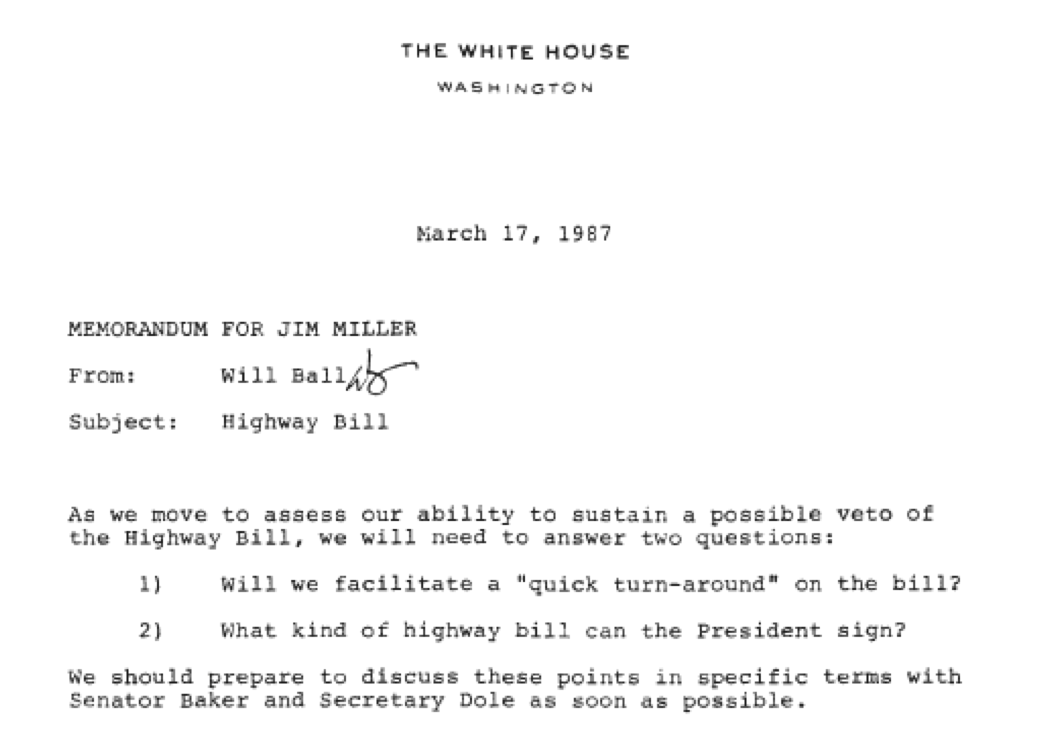
The conference report certainly did have a lot of demonstration projects – a master list showed 170 of them (with White House staff handwritten scribbling on the right trying to assign Senate projects to individual Senators), and an earlier list of the House projects attributed those to individual House members. The conference report also included a new minimum allocation program giving states with few or no demo projects money to compensate for their lack of earmarks. And OMB quickly produced a list of the top 10 earmarks.
On March 18, the House adopted the conference report by a vote of 407-17. And since the House-passed bill had not addressed the 65 mph speed limit issue, Howard dealt with it by having the House take a separate vote on an “enrollment correction resolution” (H. Con. Res. 77, 100th Cong.) to add the Senate 65 mph language to the conference report by a vote of 217-206. Republican Senators began calling the White House urging the President not to veto the bill.
Jim Wright’s biographer wrote that a successful veto “would demonstrate that Reagan was still in control in Washington, that regardless of the Iran-contra affair, regardless of Democrats taking the Senate, regardless of Jim Wright’s ambitions, he was still the boss. He could veto everything, drive the business of government to a halt, compel Congress to accede to his wishes.” (Barry 180.)
Reagan personally wrote to Congressional leaders on March 19 to express his opposition to the demonstration projects and the transit funding and to say “If this bill is presented to me in its current form, I will return it to Congress without my signature.”
But that day, at 5:28 p.m., the Senate voted to agree to the conference report, 79 to 17. Only 16 Republicans and one Democrat (Terry Sanford, D-NC) had voted with the President and against the bill, while 51 Democrats and 28 Republicans had voted to pass the bill in the face of a promised veto. Reagan talked on the phone with Bob Dole at 9:28 p.m. that night.
The Senate still had to vote on the concurrent resolution adding the 65 mph speed limit, and so theoretically, it was not too late to change the final bill. White House staff got Reagan’s approval to start talking about an alternative bill that would spend $4.5 billion less over five years, funded all demo projects from within state formula money, and killed the Big Dig and LA Metrorail provisions.
The discussion assumed that someone in the Senate could try to offer the President’s alternative to the 65 mph resolution, but Burdick, Stafford, Moynihan and Highways Subcommittee ranking member Steve Symms (R-ID) sent a letter to their colleagues asking them to oppose any amendments to the resolution (see 133 Cong. Rec. 6463-6464), and Minority Leader Dole indicated that the Administration alternative amendment was not yet available at that moment, and he did not want to delay things, because “If the President is going to veto it, it should be done and done quickly.” (133 Cong. Rec. 6468.) The 65 mph resolution was enacted by a vote of 60 to 21, clearing the highway bill for the White House.
Dozens of Republican Members of Congress began writing to Reagan urging him not to veto the bill, including future Speaker Dennis Hastert (R-IL) and future transportation chairman Bud Shuster (R-PA). But perhaps the most poignant came from longtime House Republican Leader Bob Michel, writing, “I would hope that you can reconsider your position…A veto of this bill will surely put me personally between ‘a rock and a hard place’, and I just have to tell you that, Mr. President, in the hope that you will reconsider…” However, the White House issued a statement by the President on the 20th declaring that he would veto the bill, insisting that “Congress can’t have it both ways. They cannot talk about cutting unnecessary deficit spending and then vote in favor of bills that bust the budget.”
Somewhere around this time, DOT sent the White House a draft of a letter that they wanted to have Senators sign and send to the President declaring their support for a veto.
On the 19th, the Administration had circulated a one-page table alleging that 41 states would receive lower formula apportionments under the conference bill than under the original Senate-passed bill. It was also at this time that Senators Moynihan and Mitchell took to the Senate floor to complain that the Administration used inaccurate state formula funding numbers in the table – Moynihan actually used the word “lying” and demanded that whoever in DOT Congressional Relations put together the table be fired immediately. A week later, DOT sent out a detailed refutation of Moynihan’s complaints.
The White House quickly organized an all-out campaign to convince at least 16 Republican Senators who had voted for the conference report to switch sides and vote to sustain a veto, on the assumption that the 16 Republicans and one Democrat who had voted “no” on the conference report would remain consistent and sustain the veto, and that William Armstrong (R-CO), who had missed the vote on the conference report, was still as opposed to the bill as he was when he filed blistering dissenting views in the Banking Committee’s report on the transit title. Those 18 Senate votes plus 16 more would total 34, the bare minimum margin for sustaining a veto in a 100-vote Senate. (The House was considered a lost cause.)
Transportation Secretary Dole and her husband met with Reagan and his senior staff on the morning of the 23rd and then she issued a statement in strong support of the veto. White House legislative affairs staff divided up Senators to be contacted by Administration officials and produced a “shopping list” of favors that might be traded to get the support of certain Senators. Reagan made some phone calls to Senators himself, including Kit Bond (R-MO), after which Reagan wrote, “don’t think I moved him.” The staff suggested trading the Administration’s position on an agriculture bill for the highway veto vote of Rudy Boschwitz (R-MN), and they even went so far as to get a legal opinion on the propriety of Reagan doing a voice-over for a documentary about Mount Rushmore to get the vote of Larry Pressler (R-SD).
Reagan, Vice President Bush, and Bob Dole met directly with Bob Stafford on the morning of the 24th to ask for his support in sustaining the veto. Reagan then met with the combined House and Senate GOP leadership, which he wrote about in his personal diary afterwards, saying, “Much of the time spent on the Highway bill & my veto of same. Bob Dole made a speech about supporting me that drew applause from his colleagues. 1st time I’ve ever seen that.”
Staff planned for the President to throw a cocktail party on March 30 for Senators to lobby them directly (but that seems to have never taken place). And they continued to focus on the “pork” in the bill – DOT compiled a list of “unneeded” demonstration projects, OMB put together a summary of the major special interest projects and programs in the bill, and special attention was paid to the L.A. Metrorail provision.
On March 25, the senior conferees on the highway bill (with the notable exception of Bob Stafford) wrote to Reagan to urge him to “act quickly and to accept the conference report on H.R. 2 so that our highway program can move ahead without further delay.” The conferees also wrote to the chairman of the National Governors Association (Bill Clinton of Arkansas) to ask state governors to call their Congressional delegation in support of a veto override. A group of governors had written Reagan the day before urging him to sign the bill.
By Thursday March 26, the White House legislative affairs office tally sheet showed 26 firm votes to support the veto (25 Republicans and Sanford), two leaning towards the White House, 11 undecided and 12 leaning against. They needed to sway eight more Republicans out of the 25 listed in the leaning for, undecided and leaning against categories.
The President was presented with the enrolled bill memo from OMB on Friday March 27 and signed his veto message at an 11 a.m. ceremony, telling reporters “The bill’s a textbook example of special interest, pork-barrel politics at work, and I have no choice but to veto it.” The message went straight to the Clerk of the House.
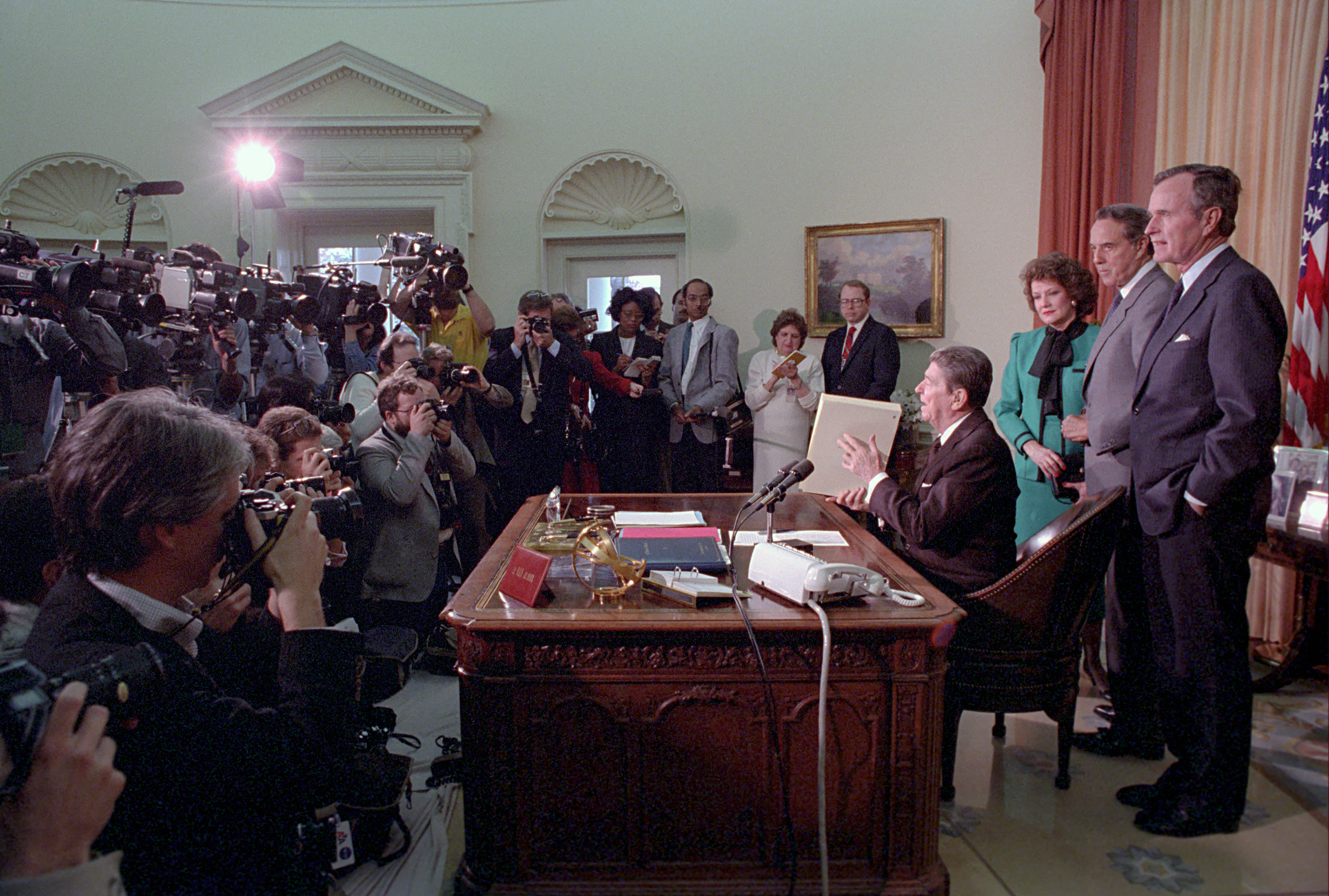
President Reagan prepares to sign the veto message on H.R. 2 on March 27, 1987, in front of Vice President George Bush, Senate Majority Leader Bob Dole, and Transportation Secretary Elizabeth Dole (and a crowd of reporters). Photo courtesy of the Reagan Library.
Reagan then met with Steve Symms, Chic Hecht (R-NV) and John McCain (R-AZ) to ask for their support. Reagan later wrote in his diary that “Hecht & Symms have some problems but I believe we have good chance. John McKain [sic] is with us.” On Saturday the 28th, Reagan devoted his national radio address to the highway bill situation.
Freshman Sen. Mitch McConnell (R-KY) had been having problems with the Agriculture Department on tobacco issues and was withholding his vote. Reagan met with McConnell on Monday March 30th in the presence of Agriculture Secretary Richard Lyng. Reagan then met with Sen. Thad Cochran (R-MS) to lobby him for his vote. Reagan later wrote in his diary, “I’ve got a chance with Thad but Mitch is hung up on some problems with his tobacco farmers sounds negative on the vote.”
McConnell told Vice President Bush the following day that he was still a “no.” Lyng even took the extraordinary step of offering to resign as Agriculture Secretary if it would get McConnell’s vote on the veto, to no avail. (Ward Sinclair, “The Day Lyng Offered to Quit the Cabinet; Tobacco-State Senator Rejected Deal, Cast Key Vote Against Reagan.” The Washington Post, September 21, 1987.)
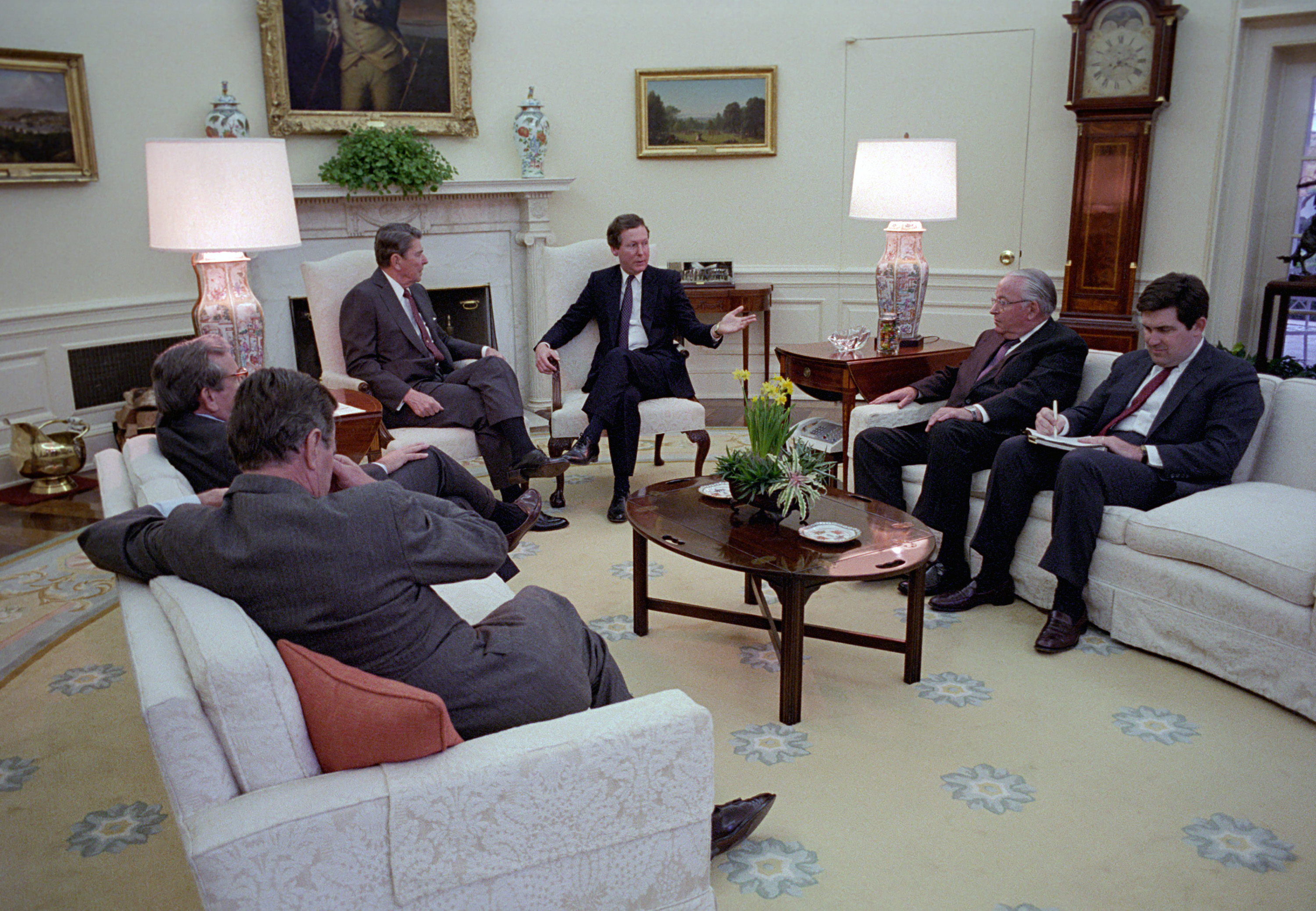
Meeting in the Oval Office, March 30, 1987. Clockwise from left foreground: Vice President George H.W. Bush, White House Chief of Staff Howard Baker, President Reagan, Senator Mitch McConnell, Agriculture Secretary Richard Lyng, White House legislative affairs aide William Ball. Photo courtesy of the Reagan Library.
Howard Baker was also making calls to Senators, including one to Nancy Landon Kassebaum (R-KS), who he would marry nine years later. On the 30th, Secretary Dole sent a letter to Congress urging support for the veto.
But Reagan had sorely misjudged Steve Symms when he wrote that he thought he had a “good chance” to get his support – on the 30th, Symms sent a “Dear Colleague” letter to all Senators with a devastatingly detailed critique of the Administration’s arguments and defending the final bill. Symms addressed the earmark issue head-on, saying, “Unfortunately, the objections of the President and many senators notwithstanding, demonstration projects are a fact of life and a highly valued commodity in the House of Representatives. In my judgment, we would not be finished with a highway conference today if the Senate conferees had not been willing to provide some additional federal funding for demonstration projects.”
The White House sent out a detailed refutation of Symms’ letter on the 31st but the damage was already done.
On March 31, the House voted, 350-73, to override the veto. Of the eight elected members of the House GOP leadership (Michel, Trent Lott (R-MS), Jack Kemp (R-NY), Dick Cheney (R-WY), Jerry Lewis (R-CA), Lynn Martin (R-IL), Bob Lagomarsino (R-CA) and Guy Vander Jagt (R-MI)), only Kemp and Lagomarsino voted with the President. An undated tally sheet from the legislative affairs office from about this time shows 22 Senators firmly committed to sustaining the veto, two leaning to sustain, and 20 “possibles.” That same day, Reagan sent each Senator a letter asking for their support on the veto override. He also called Strom Thurmond (R-SC) and offered to support a road project in Myrtle Beach in order to lock down Thurmond’s vote.
The White House was not just doing direct lobbying. Staffers were contacting governors in an attempt to get them to weigh in with Senators, and a March 31 memo summarizes the outreach that the White House had conducted with outside groups (not just groups concerned with deficits or Republican politics per se, but Christian talk radio as well). And the White House continued to work the phones and try to get Republicans to support the veto.
By the time the vote was called in the Senate on the morning of April 1, the White House actually got the 16 Republican Senators they needed – Senators who had voted “yes” on the conference report but switched and voted “no” on the veto override.
However, they were undone by the lone Democrat who had voted “no” on the conference report and who had been counted as a firm supporter of the veto in all of the vote tallies: Terry Sanford (D-NC).
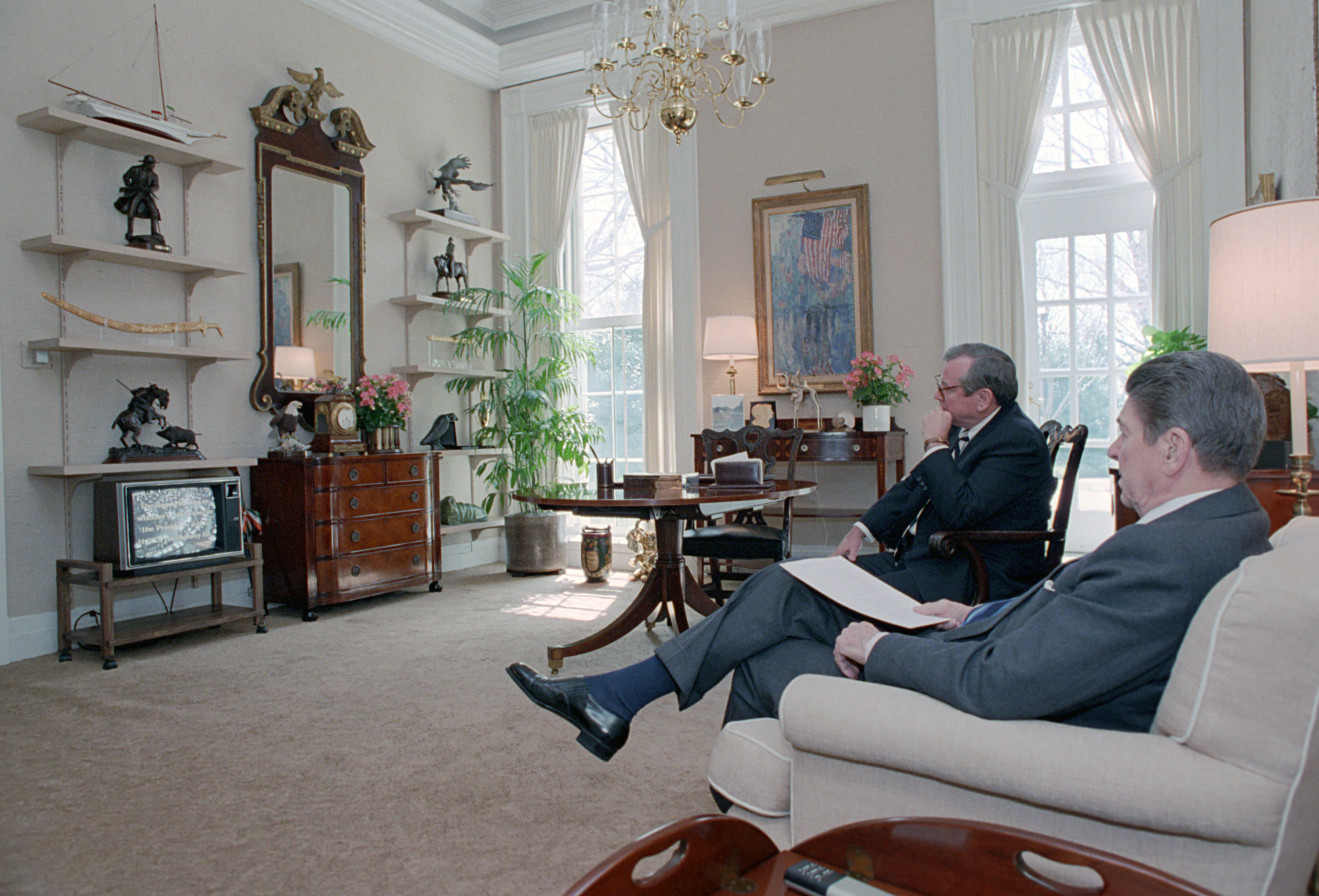
President Reagan and Chief of Staff Howard Baker sit in the study adjoining the Oval Office and watch the Senate vote on the veto override, April 1, 1987. Photo courtesy of the Reagan Library.
Sanford had promised the Democratic Lieutenant Governor of North Carolina, Bob Jordan (who was going to run for governor against the Republican incumbent, Jim Martin, in 1988), that he would vote “no” on the highway bill because its funding formulas shortchanged the Tarheel State. His fellow Democrats in the Senate, meanwhile, put intense pressure on Sanford to show party solidarity and hand the president a defeat. House Majority Whip Tony Coehlo was telling North Carolina Democratic House members that if Sanford did not support the veto override, tobacco subsidy programs would suffer. (Barry 182.)
Linda Greenhouse told the story vividly in The New York Times the next day – 98 Senators had voted and the total was 65-33. The only two Senators who had not voted were Sanford and Republican Whip Alan Simpson (R-WY). Greenhouse wrote, “First senior Democrats, then Mr. Simpson, then the Democrats again, made their pitches. Finally, looking at the Democrats, he shook his head no and made a chopping motion with his hand. Mr. Sanford then voted ‘present’ and then a few minutes later changed that to ‘nay,’ a vote to sustain the veto. Under the Senate’s rules, a vote of ‘present’ would in effect have been a vote to override the veto, because it lowers from 67 to 66 the number of votes required to override. Later, in recounting the episode, Mr. Sanford said, ‘Let’s say I was slightly confused.’” (Linda Greenhouse, “Senate, For Now, Upholds the Veto of Roads Measure,” The New York Times, April 2, 1987.)
In the face of a triumphant victory for Reagan, and realizing that Sanford felt bound by his commitment to Lieutenant Governor Jordan, Rep. David Price (D-NC) got Jordan to release Sanford from his promise in the name of the national party interest. (Barry 195.)
For what happened next, Reagan himself summarized it in his diary quite nicely: “But when 1 Dem. Terry Sanford broke ranks & voted with us – the winning vote – Bob Byrd switched his vote to us so he could demand reconsideration. You have to be a vote on winning side to call for reconsideration. All day on A.F. 1 in Phil. We’ve been back & forth on the phones trying to line up votes but then Byrd has been busy too. Terry Sanford stood up and announced he was changing his vote – looks like we’re behind.”
That last sentence in Reagan’s diary refers to later on April 1, when Sanford went back to the Senate floor and announced that he would be changing his vote. But no one quite believed the reasoning Sanford gave: “With pressure from no one, but with the thoughtfulness that comes from listening to and considering carefully the views of others, I shall now vote to reconsider.” (133 Cong. Rec. 7634.) Bob Dole then began a long series of delaying moves to give the White House time to try and switch one of the 13 Republicans who had voted “yes” on the override to the President’s position.
The next morning (April 2), with the reconsideration vote still pending and Dole still delaying, Reagan decided to go all-in: “I decided to go to the Hill & make my pitch to our Rep. Sens. including the 13 who are voting to override. Some of our team thought I would only look worse if I was overridden. I decided I couldn’t live with myself if I didn’t go.” Reagan left the White House just after 11 a.m. and would spend nearly two hours in the Capitol. Reagan wrote in his diary later that “I met 1st with a large group of Sens. in old Sen. Chamber. Then with the 13 in Bob Dole’s office.” In that meeting with the 13 holdouts, President Reagan actually used the word “beg,” as in “I beg you for your vote.” (Walter Shapiro, “Road Warriors,” Time, April 13, 1987.)
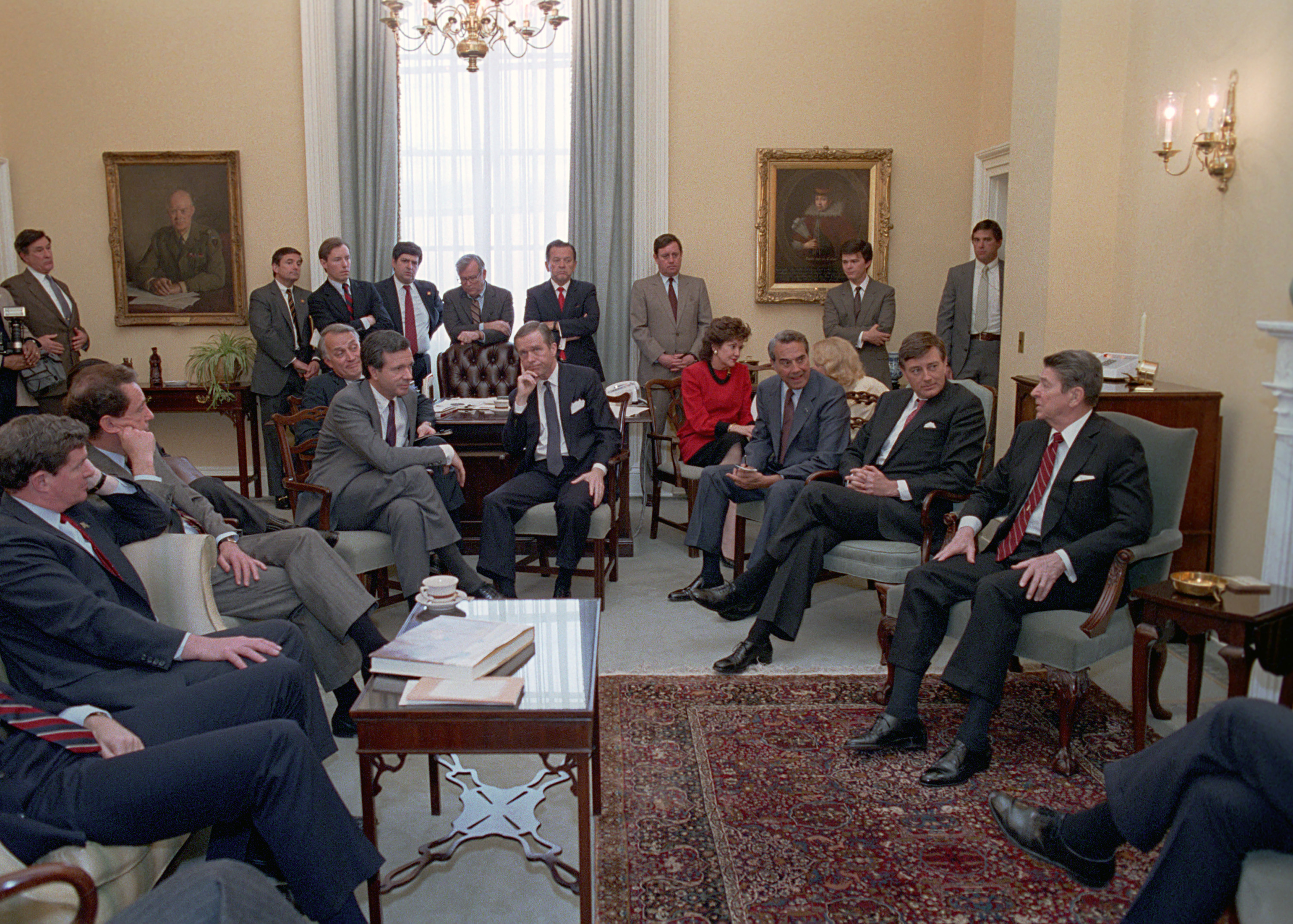
President Reagan meets with the 13 Republican holdout Senators in Majority Leader Dole’s office in the Capitol to beg for their votes on the highway bill veto override, April 2, 1987. (Photo courtesy of the Reagan Library.)
But Reagan’s desperate plea proved fruitless. Again, Reagan’s diary: “I knew when I left I’d failed but I have no respect left for that 13. They were voting on strictly the pressure they were getting from the construction industry and they were voting against trying to balance the budget.”
Reagan went back to the White House to meet with the NCAA women’s basketball champion Tennessee Lady Vols, where Reagan joked about the ongoing veto drama: “Leon Barmore, the coach of that fine Louisiana Tech team that you defeated, said that ‘Tennessee played the greatest defensive game I’ve ever seen.’ Well, believe me, I had a special feeling about all of you coming here today because, as perhaps you know, lately I’ve been playing a little defensive ball myself.”
The denouement, from Reagan’s diary: “Back to the Cab. room for an Ec. policy meeting on the upcoming Canada meeting. In the meeting was handed a note – we’d lost on the veto vote 67-33. 1 vote short. A brief Personnel meeting & then Admin. time – some departure pictures, then a group of Hasidic rabbis. Also the Am. Cancer Society with Minnie Pearl. On to W.H. Public sentiment including even some Dem. Sens. seems to be favoring me in my defeat.”
Reagan’s brief official statement on the override promised that “My efforts to control spending are not diminished, and I remain firm in my pledge to the American taxpayers to speak out against such budgetary excesses.” That evening, Reagan sent the 33 Republican Senators who had supported his position personalized thank-you notes. (See list of how all Senate Republicans voted at the end of this article.)
The Surface Transportation and Uniform Relocation Assistance Act of 1987, enacted over the President’s veto, became Public Law 100-17.
(Click here to download the full Documentary History of the 1987 Highway Bill Veto – a large PDF file that contains the above narrative along with dozens of original documents (mostly from the Reagan Library) that are hyperlinked from the appropriate place in the narrative. Readers are encouraged to download the PDF file instead of viewing it through a browser so they can use the bookmarks and jump to documents separately.)











